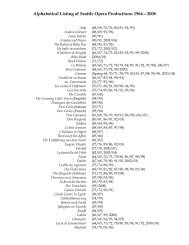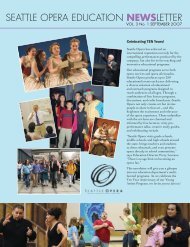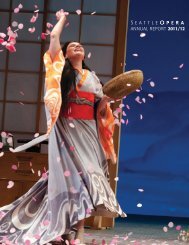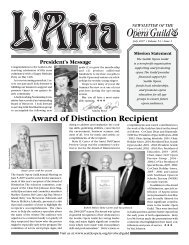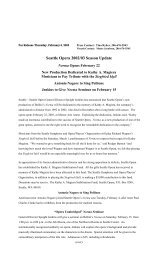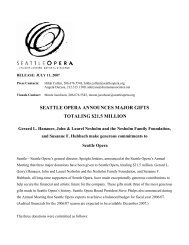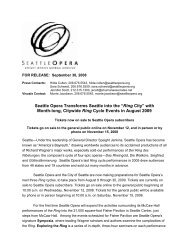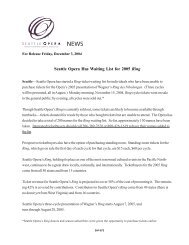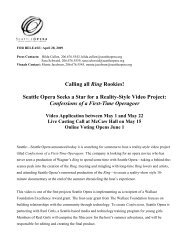Create successful ePaper yourself
Turn your PDF publications into a flip-book with our unique Google optimized e-Paper software.
Nuccia Focile as Elle in La Voix Humaine, Cocteau Voices, Royal <strong>Opera</strong>, Covent Garden, (Tristram Kenton photo)<br />
spotlight on<br />
<strong>LA</strong> <strong>VOIX</strong><br />
<strong>HUMAINE</strong><br />
Music by Francis Poulenc<br />
Libretto by Jean Cocteau<br />
First performed Paris, 1959<br />
In French with English Captions<br />
At <strong>Seattle</strong> <strong>Opera</strong> May 2013<br />
Production Sponsor ArtsFund<br />
26 2012/13 Season at <strong>Seattle</strong> <strong>Opera</strong>
Long Story Short<br />
A relationship of five years will end when this<br />
phone call ends...so let’s keep talking.<br />
Who’s Who?<br />
Elle (“She”) is young, elegant, and unhappy<br />
about being dumped.<br />
On the phone with her is a man she calls “Chéri”<br />
(the cherished one), as well as telephone<br />
operators and miscellaneous other callers. She<br />
speaks with Chéri about her friend Marthe and<br />
the dog.<br />
Where and When?<br />
A woman’s bedroom, probably in Paris, midtwentieth<br />
century.<br />
What’s Going On?<br />
He left her three nights ago, and tonight they’re<br />
on the phone, trying to say goodbye. But how to<br />
end it properly—particularly when it’s so hard to<br />
get a good connection? The call keeps getting<br />
dropped, random people keep eavesdropping on<br />
the conversation, and the two of them have a<br />
hard time telling one another the truth.<br />
“Yes, I had a hard time sleeping last night, and<br />
took a pill,” she tells him. “Then, this morning,<br />
Marthe came by early.” She goes on to lie about<br />
what she’s wearing, and they are almost flirting<br />
when once again the line cuts out. She calls his<br />
house, only to discover that he’s not there—he<br />
must have been calling from somewhere else.<br />
When he calls back, and continues to lie—“Oh,<br />
that music you hear? No, I’m not at a party...<br />
that must be the neighbors, playing their<br />
gramophone”—she is emboldened to tell him<br />
the truth: she isn’t dressed up, she hasn’t had<br />
dinner, and she didn’t take one pill, she took<br />
all of them. When Marthe came, she brought a<br />
doctor, and the woman’s suicide attempt failed.<br />
But after five years of a relationship, it’s terrible<br />
to be alone; even the woman’s dog understands<br />
something is terribly wrong. When she comes to<br />
understand that her lover has lied to her only in<br />
an attempt to lessen the hurt, his kindness gives<br />
her the strength to tell him, “Go ahead, hurry,<br />
hang up. Do it quickly. I love you....”<br />
History of a Bad Connection<br />
If you’ve had trouble with your cell phone carrier,<br />
or an unreliable wireless router, you’ll identify<br />
with the protagonist of La voix humaine, whose<br />
attempt to make an important phone call is<br />
continually thwarted by the crummy phone<br />
service where she lives. Much of the dramatic<br />
tension and humor of La voix humaine come<br />
from the constant interruptions, which were a<br />
familiar feature of urban telephone systems into<br />
the mid-twentieth century.<br />
This opera takes place long before area codes,<br />
back in the days of exchange names; for instance,<br />
Elle, trying to dial her Chéri, asks her operator<br />
to dial “Auteuil 04/7.” Not until after World War<br />
II did modern telephone numbering systems<br />
come into use, and it took decades for them to<br />
become ubiquitous. Although Poulenc wrote the<br />
opera in the late ’50s, he was clearly delighted<br />
to remember the unpredictable phone service of<br />
his youth—witness the rattling xylophone in his<br />
score each time the woman’s telephone rings.<br />
About the Writer and<br />
CoMPoser<br />
La voix humaine is a play written in 1930 by<br />
Jean Cocteau and set to music in 1959 by Francis<br />
Poulenc. Cocteau and Poulenc, who first met in<br />
1917, were both major figures<br />
in twentieth-century art, music,<br />
poetry, theater, dance, and film.<br />
Given their varied interests,<br />
limitless energy, and the<br />
extraordinary times they lived<br />
through, the world of French<br />
culture swirled around these<br />
two figures for four decades.<br />
When they first met, Cocteau<br />
(born 1889) was a hyperactive<br />
young artist and arts publicist,<br />
and Poulenc (born 1899) was<br />
a musically inclined teenager<br />
from a well-to-do family. The<br />
Rite of Spring had turned the<br />
Paris arts scene on its head a<br />
few years previously: Stravinsky’s<br />
wild score so polarized<br />
the musical world that when<br />
Poulenc applied to study at the conservative<br />
Paris Conservatoire, the composition teacher<br />
who judged his work screamed, “I see you’re a<br />
follower of the Stravinsky and Satie gang. Well,<br />
goodbye!” and threw him out the door. The<br />
hedonistic lifestyle associated with the Ballets<br />
Russes, and others in the world of the arts at<br />
the time of the World War I, emboldened these<br />
two artists, both of whom were gay, to pursue<br />
authentic love lives, whatever society might<br />
think. Both had on-again-off-again relationships<br />
with the Catholic Church; both endured<br />
the Fascist take-over of France during World<br />
War II (and both have been criticized for not<br />
standing up heroically to fight the Nazis); and<br />
both died in 1963, well-respected old lions who<br />
had become role models to later generations of<br />
artists.<br />
Cocteau may be best known in the United<br />
States today for his films, particularly his dreamy<br />
Beauty and the Beast and his three Orpheusinspired<br />
films: Blood of a Poet, Orpheus, and The<br />
Testament of Orpheus (all of which star his lover,<br />
Jean Marais). But he was equally productive as<br />
artist, poet, novelist, critic, and designer. He<br />
wrote La voix humaine in 1929, the same year<br />
that he described his recovery from addiction<br />
in the book Opium, Diary of a Detoxification.<br />
“Portrait of Jean Cocteau (with multiple hands),” Philippe Halsman, 1948<br />
2012/13 Season at <strong>Seattle</strong> <strong>Opera</strong> 27
Aria Ready?<br />
Nuccia Focile, Elle<br />
A woman is trying to stay connected<br />
to her lover on the telephone.<br />
Ron Scherl photo<br />
Tristram Kenton photo<br />
Poulenc’s Dialogues of the Carmelites at <strong>Seattle</strong> <strong>Opera</strong> in 1990<br />
La voix humaine was written partly in response lotine, Dialogues was a big hit at its 1957 La<br />
to a complaint from an actress that his scripts Scala premiere, and was quickly performed by<br />
were so pre-determined by writer and director opera companies in London, Paris, Vienna, and<br />
there wasn’t much in them for actors to do. La San Francisco. <strong>Seattle</strong> <strong>Opera</strong> first produced it in<br />
voix humaine continues to be produced as a play 1990. Poulenc wrote La voix humaine immediately<br />
following Dialogues, for the soprano Denise<br />
all over the world.<br />
Duval. Cocteau’s play provided suitable inspiration<br />
for a witty man who loved dogs and had<br />
Poulenc may not have broken as much new<br />
ground as some twentieth-century composers of<br />
a history of unstable relationships and abusing<br />
classical music, but audiences have always taken<br />
sleeping pills.<br />
to his work. He expressed in music both the<br />
smiling, eager-to-please side of his personality,<br />
Donna Abbandonata<br />
and also his deep insecurities: his hypochondria,<br />
need for love, and quest for faith. A prolific<br />
La voix humaine is technically a “monodrama,”<br />
composer of songs, he also wrote much religious<br />
an opera for only one character. Another such<br />
music, some popular chamber music, but no<br />
piece, Schoenberg’s Erwartung, was produced in<br />
symphonies—although orchestras sometimes<br />
2009 at <strong>Seattle</strong> <strong>Opera</strong>. Like Erwartung, La voix<br />
play the suites made from his ballets Les Biches<br />
humaine is a tour-de-force for a solo soprano,<br />
and Les Animaux modèles, concertos, and other<br />
whose character must come to terms with the<br />
works. The BBC commissioned his History of<br />
end of a relationship.<br />
Babar the Elephant for piano and narrator, a It turns out that this kind of piece has a long and<br />
typically crowd-pleasing collection of vignettes proud tradition going back to the earliest days of<br />
based on a children’s book.<br />
opera. In fact, one of opera’s very first subjects,<br />
Poulenc wrote three operas. Les Mamelles de<br />
set by Monteverdi, was Ariadne abandoned by<br />
Tirésias is a gender-bending comedy based on<br />
Theseus on the island of Naxos. Other abandoned<br />
a surreal text by Guillaume Apollinaire, another<br />
heroines who have inspired opera composers for<br />
colorful character whom Poulenc had known<br />
centuries include Virgil’s Dido and Tasso’s Armida.<br />
briefly during World War I. Poulenc’s masterpiece,<br />
Dialogues of the Carmelites, was written island, the woman in La voix humaine may<br />
Unlike Ariadne, marooned on her desert<br />
in the 1950s. The story of a timid French girl be abandoned, but she’s hardly alone, given<br />
who, during the French Revolution, overcomes all the people chattering away on her telephone<br />
her fear of death and goes boldly to the guil- line.<br />
SO: You are the only person onstage<br />
during this opera, so you are, in a<br />
sense, singing one long aria. What<br />
is challenging about being onstage<br />
by yourself for 40 minutes?<br />
NF: You really have to carry the whole show<br />
on your shoulders. The entire story is<br />
based around this telephone, which<br />
connects this woman to everybody else<br />
involved in the story. I have to act my<br />
role, but I also have to act everybody<br />
else because the only way for the<br />
audience to understand and imagine<br />
what the other person is saying to me<br />
is through the expression on my face.<br />
The voice is really dictating everything,<br />
which is why there must be such a big<br />
understanding between the conductor,<br />
the director, and the singer. Sometimes,<br />
for example, the music cannot start until<br />
I do a particular movement or reaction,<br />
and that reaction happens in the silence.<br />
It doesn’t always take the same amount<br />
of time. Evenings can be shorter, some<br />
can be longer. I have to find courage<br />
to sustain those moments of silence. It<br />
really is more like a play than an opera.<br />
SO: Have you actually scripted what the<br />
people on the other line are saying?<br />
NF: I have my phrases in my mind, so I know<br />
exactly how to react to it.<br />
SO: Have you performed this role before?<br />
NF: I performed this role last year in Covent<br />
Garden in London in English. In <strong>Seattle</strong>,<br />
we will do it in French, so in a way it will<br />
be like doing it for the first time. When<br />
you sing it in French, it becomes more<br />
elegant, lighter. The language and the<br />
music are so perfect together.<br />
2012/13 Season at <strong>Seattle</strong> <strong>Opera</strong> 29
30 2012/13 Season at <strong>Seattle</strong> <strong>Opera</strong><br />
Teatro Massimo, Palermo
Aria Ready?<br />
spotlight on<br />
SUOR<br />
ANGELICA<br />
Maria Gavrilova, Angelica<br />
“Senza mamma”<br />
Angelica reacts to the news of<br />
her son’s death.<br />
Long Story Short<br />
After sin comes penitence and forgiveness for a<br />
loving mother.<br />
Who’s Who?<br />
Sister Angelica, who knows the powers of<br />
every herb in the convent’s garden, has been a<br />
nun for seven years—but has yet to find peace.<br />
The Princess, her wealthy aunt, likes to<br />
appear pious and noble, although really she is<br />
manipulative and cruel.<br />
Sister Genovieffa, who used to be a shepherdess,<br />
misses her darling little lambs.<br />
Sister Dolcina (“Sweet-Tooth”) likes to<br />
commit the sin of gluttony.<br />
The Abbess is trying to run a serious convent;<br />
no “Nunsense” here.<br />
Where and When?<br />
A convent in northern Italy, late seventeenth<br />
century.<br />
What’s Going On?<br />
For seven years Sister Angelica has led the quiet<br />
life of a nun. Not much happens at her convent:<br />
every so often special treats, such as currants,<br />
Music by Giacomo Puccini<br />
Libretto by Giovacchino FoRZano<br />
First performed New YoRK City, 1919<br />
In Italian with English Captions<br />
At <strong>Seattle</strong> <strong>Opera</strong> May 2013<br />
Production Sponsor ArtsFund<br />
come in with the donations of food; and once<br />
a year the sunlight through a certain window<br />
strikes the fountain and turns the water golden.<br />
The nuns follow a strict rule, and spend most of<br />
their time in prayer. And none of the other nuns<br />
really understands why Angelica is there.<br />
Born a princess, Angelica was forced to become<br />
a nun when she bore a child out of wedlock. The<br />
opera takes place the day Angelica finally receives<br />
a visit: it is her aunt, who needs her to sign<br />
some family documents. Angelica’s little sister<br />
will marry, the aunt explains; they have found<br />
a man who agrees to look past the shameful<br />
stain Angelica left on their once-glorious family<br />
name. But first Angelica must sign away her<br />
inheritance. Angelica is more interested in what<br />
became of her baby. “Two years ago he took<br />
sick,” her aunt responds. “Everything was done<br />
to save him, but....”<br />
Angelica signs her aunt’s document, and the old<br />
woman leaves her alone. Desiring more than<br />
anything to be with her son, she collects herbs<br />
from the convent garden, prepares poison, and<br />
drinks it. Suddenly realizing that in her desperate<br />
love she has committed a mortal sin, Angelica<br />
prays to the Virgin Mary, imploring salvation,<br />
and as she dies, she receives a sign of grace—a<br />
vision of her dead son.<br />
SO: Does your character change as she<br />
sings this aria?<br />
MG: Angelica starts the aria with sadness<br />
for both her child and herself, that they<br />
never knew each other’s love. At first<br />
she is sad (the aria begins in A Minor),<br />
imagining him dying alone and unloved.<br />
She then thinks that he is happy in<br />
heaven (changing to F Major), and<br />
thinks how happy she will be when they<br />
are together in heaven.<br />
SO: Do you remember the first time you<br />
heard this aria?<br />
MG: Yes, when I was a student in Moscow<br />
Conservatory, I heard Mirella Freni sing<br />
it on an EMI aria recording from the<br />
1960s. The performance I like the best<br />
is a video from La Scala with Rosalind<br />
Plowright. With both singers, I was<br />
impressed by how they used their voices<br />
in such a difficult aria with feeling.<br />
SO: What do you like most about<br />
singing this aria?<br />
MG: Angelica is a combination of sweetness<br />
and power.<br />
SO: What’s most challenging about it?<br />
MG: The pianissimi high notes in the aria are<br />
challenging and even more so at the<br />
end in the prayer that follows the aria.<br />
SO: After “Senza mamma,” you’re still<br />
the only one onstage. How is the<br />
rest of the opera different from the<br />
part that’s technically considered<br />
the aria?<br />
MG: After the aria, Suor Angelica loses her<br />
rational mind and is in ecstasy thinking<br />
about her son and herself in heaven.<br />
This music, not only the singing, but the<br />
orchestra too, is what we think of as<br />
real Puccini.<br />
2012/13 Season at <strong>Seattle</strong> <strong>Opera</strong> 31
Puccini Seeks<br />
New Adventures<br />
After the success of La bohème, Puccini was<br />
on top of the world. But by the time he wrote<br />
Madama Butterfly, eight years later, the musical<br />
intelligentsia, particularly hungry for novelty<br />
in those watershed days of “modern” music,<br />
were accusing him of resting on his laurels and<br />
repeating past successes. (It’s true that Butterfly<br />
first steps onstage to a slowed-down version of<br />
Musetta’s Waltz!) So following Butterfly, Puccini<br />
was indeed on the lookout for projects that<br />
would stretch him in new directions.<br />
In 1907, he was invited to New York to supervise<br />
performances of his operas at the Metropolitan<br />
<strong>Opera</strong>. Puccini ended up writing an opera for<br />
the Metropolitan: La fanciulla del West, a very<br />
American story about a plucky, can-do barmaid<br />
in a California mining town. During World War I,<br />
Puccini tried his hand at writing a Viennese-style<br />
operetta, La rondine, which premiered in Monte<br />
Carlo. And as the war ended, he put together Il<br />
trittico, a series of three one-act operas which<br />
also premiered at the Metropolitan. Together they<br />
form an almost Dantesque progression through<br />
hell, purgatory, and paradise; but because they<br />
make vast demands on an opera company, it’s<br />
rare nowadays to see all three on the same<br />
evening. Il tabarro is a gritty story of jealousy<br />
and murder among low-lifes, set on a barge on<br />
the Seine; Suor Angelica, one of the few operas<br />
to feature an all-female cast, contains some<br />
of Puccini’s most breathtaking, and certainly<br />
his most mystical, music; and Gianni Schicchi,<br />
his only comedy, rounds out this magnificent<br />
triptych with laughter and love.<br />
Puccini and His<br />
Suffering Women<br />
In Act III of Manon Lescaut, Puccini’s first operatic<br />
triumph, a parade of “undesirable women” (i.e.,<br />
prostitutes) are brought onstage one by one,<br />
publically humiliated by having their hair cut<br />
off, and then forced to board a ship headed for<br />
the new world—deported for their sins. In a way,<br />
this scene foreshadowed what Puccini was to do<br />
for the rest of his career. In opera after opera,<br />
he makes his audience cry by showing them the<br />
pathetic suffering of a beautiful woman whose<br />
only crime is love. In La bohème, Mimì dies of<br />
Top: In Madama Butterfly, Cio-Cio-San kills herself when Kate Pinkerton asks her to give up her child. Bottom:<br />
In Turandot, Liù kills herself so Turandot will give Calaf her love.<br />
tuberculosis, a disease associated with sinful<br />
lifestyles in the nineteenth-century imagination.<br />
Puccini heroines who kill themselves after<br />
psychological torture—and losing whomever they<br />
most love— include Tosca, Madama Butterfly, Suor<br />
Angelica, and Liù. Puccini was well aware of the<br />
sadistic streak to his creativity, and even made his<br />
peace with it. As he died of throat cancer, Puccini<br />
joked that the seven radium crystals inserted into<br />
his neck were the revenge of the seven sopranos<br />
who die in his operas.<br />
But it’s an oversimplification to think that all<br />
Puccini heroines are pathetic victims who endure<br />
heartless cruelty and then kill themselves. There’s<br />
another kind of woman in Puccini’s operas, an<br />
assertive, powerful goddess who knows what<br />
she wants and goes after it. She may be sympathetic,<br />
like Musetta in La bohème or Minnie in<br />
La fanciulla del West, or not, like the Princess in<br />
Suor Angelica; but she always stands tall among<br />
all the strong women you’re likely to encounter<br />
on the opera stage. Turandot, Puccini’s final<br />
masterpiece, features both archetypes in its<br />
fearsome princess and suicidal slave girl.<br />
These two characters are eerily reminiscent of<br />
two real women in Puccini’s life. An avid sports<br />
car enthusiast, Puccini was in a car accident in<br />
1903. He hired a live-in nurse to help him regain<br />
<strong>Seattle</strong> <strong>Opera</strong>, 2012, (Elise Bakketun photo)<br />
Turandot, Pittsburgh <strong>Opera</strong>, 2011 (David Bachman photo)<br />
32 2012/13 Season at <strong>Seattle</strong> <strong>Opera</strong>
his health, and kept her on as a maid when he<br />
recovered. The girl’s name was Doria Manfredi;<br />
she belonged to a respectable family in their<br />
village of Torre del Lago and by all accounts was<br />
a hard worker and a gentle, pleasant person.<br />
In 1904, Elvira Gemingani’s husband died and<br />
she was finally free to marry Puccini (for more<br />
context see page 46). No sooner had she married<br />
him than she became jealous and possessive. She<br />
grew suspicious of her husband with Doria, their<br />
pretty maid. One evening in the autumn of 1908<br />
Elvira found the two of them talking near the<br />
garden. She accused Doria of having an affair<br />
with her husband, fired her, slandered her in the<br />
town, and urged the priest to excommunicate<br />
her. Puccini was a well-known womanizer, and<br />
many citizens of Torre del Lago believed Elvira.<br />
Poor Doria, unable to endure the suspicion and<br />
scandal, took poison and died.<br />
Doria’s family had an autopsy performed, and it<br />
was determined that the girl had died a virgin.<br />
They took Elvira Puccini to court for defamation<br />
of character and won the case. Elvira would have<br />
had to spend five months in prison,<br />
had Puccini not paid off the family.<br />
Although at first he wanted a separation,<br />
eventually the composer<br />
was reconciled with his wife.<br />
Years later, Puccini wrote a friend, “Always before<br />
my eyes I have the image of that poor victim<br />
and her suffering at the hands of a powerful<br />
woman.” And years after that, he dramatized this<br />
encounter, between Liù and Turandot, between<br />
Suor Angelica and her aunt. When Puccini<br />
played the score of Suor Angelica for his sister<br />
Iginia, who was a nun, she and her fellow sisters,<br />
in tears, offered absolution to Puccini’s fictional,<br />
sinful, loving, suffering Angelica.<br />
Speight Jenkins Introduces<br />
The Artists of La Voix Humaine<br />
and Suor Angelica<br />
Elle:<br />
Nuccia Focile<br />
Soprano (Militello, Sicily)<br />
Recently at <strong>Seattle</strong> <strong>Opera</strong>:<br />
Violetta, La traviata (’09)<br />
One of the world’s best<br />
loved sopranos, Ms.<br />
Focile scored a great<br />
success with La voix<br />
humaine in London. She has sung both Mimì<br />
and Violetta in <strong>Seattle</strong> and is a frequent artist<br />
at all the major opera houses of the world.<br />
Angelica:<br />
Maria Gavrilova<br />
Soprano (Chelyabinsk City,<br />
Russia)<br />
<strong>Seattle</strong> <strong>Opera</strong> debut<br />
This Russian-born artist<br />
has a rich Verdi or verismo<br />
voice, scoring major<br />
successes in Europe and<br />
at the Metropolitan <strong>Opera</strong>.<br />
The Princess:<br />
Rosalind Plowright<br />
Mezzo-Soprano (Worksop, UK)<br />
Recently at <strong>Seattle</strong> <strong>Opera</strong>:<br />
Klytämnestra, Elektra (’08)<br />
Over a great career in<br />
England, Europe and<br />
the United States, Ms.<br />
Plowright has always<br />
amazed her audiences with her grasp of<br />
the innermost meanings of the words that<br />
she sings. Her Klytämnestra here in 2008<br />
was astonishing in her power and curious<br />
vulnerability.<br />
Conductor<br />
Gary Thor Wedow<br />
(La Porte, IN)<br />
Recently at <strong>Seattle</strong> <strong>Opera</strong>:<br />
Orphée et Eurydice (’12)<br />
Extraordinarily successful<br />
at <strong>Seattle</strong> <strong>Opera</strong><br />
with Gluck, Handel and<br />
Mozart, this brilliant conductor<br />
has spent much of his life conducting<br />
Italian and French opera of the nineteenth and<br />
twentieth centuries.<br />
Director<br />
Bernard Uzan<br />
(Paris, France)<br />
Recently at <strong>Seattle</strong> <strong>Opera</strong>:<br />
Attila (‘12)<br />
Set & Costume Designer:<br />
Pier Paolo Bisleri<br />
<strong>Seattle</strong> <strong>Opera</strong> debut<br />
Lighting Designer<br />
Connie Yun<br />
(East Lansing, MI)<br />
Recently at <strong>Seattle</strong> <strong>Opera</strong>:<br />
Orphée et Eurydice (’12)<br />
The sets and costumes<br />
were successful in<br />
Trieste; Uzan has staged<br />
some of the most interesting<br />
productions here in recent seasons and<br />
has a particular affinity both to verismo and<br />
the works of Poulenc and worked with Ms. Yun<br />
to achieve the memorable and telling lighting<br />
in Attila.<br />
Spotlights by Jonathan Dean, Director of Public Programs and Media and author of English captions for <strong>Seattle</strong> <strong>Opera</strong> since 1997.<br />
2012/13 Season at <strong>Seattle</strong> <strong>Opera</strong> 33




